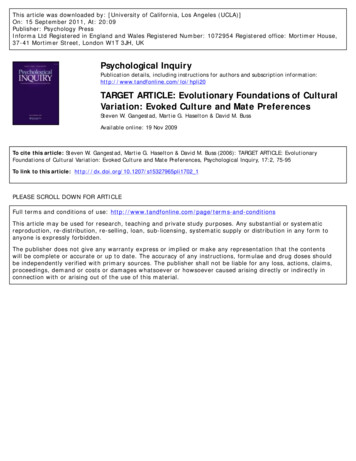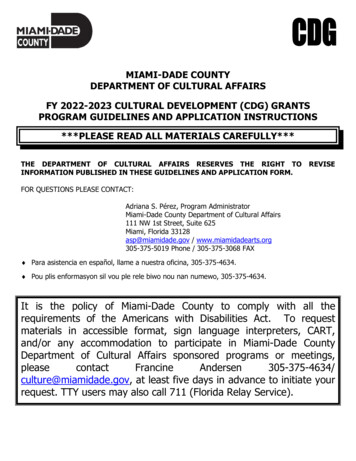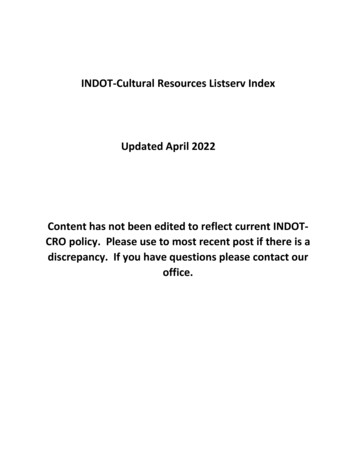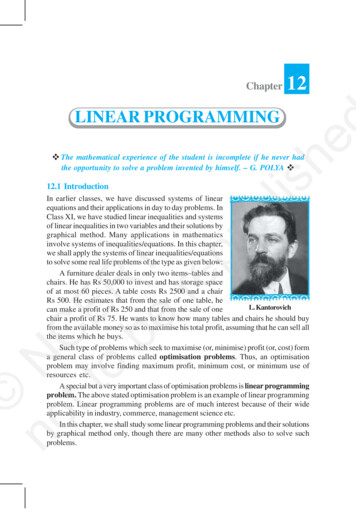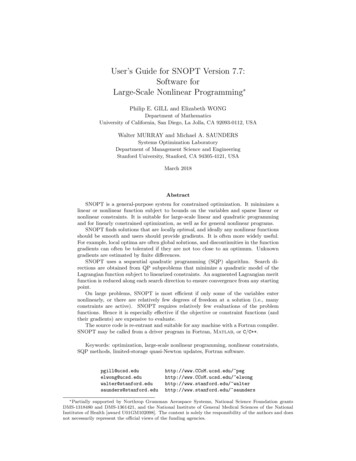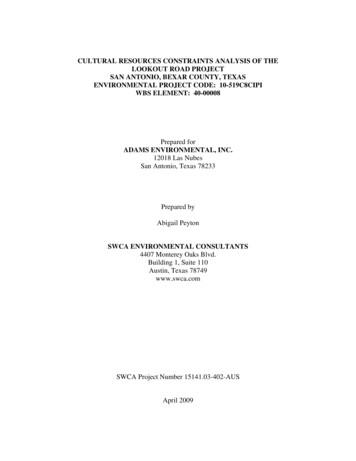
Transcription
CULTURAL RESOURCES CONSTRAINTS ANALYSIS OF THELOOKOUT ROAD PROJECTSAN ANTONIO, BEXAR COUNTY, TEXASENVIRONMENTAL PROJECT CODE: 10-519C8CIPIWBS ELEMENT: 40-00008Prepared forADAMS ENVIRONMENTAL, INC.12018 Las NubesSan Antonio, Texas 78233Prepared byAbigail PeytonSWCA ENVIRONMENTAL CONSULTANTS4407 Monterey Oaks Blvd.Building 1, Suite 110Austin, Texas 78749www.swca.comSWCA Project Number 15141.03-402-AUSApril 2009
INTRODUCTIONREGULATORY FRAMEWORKSWCA Environmental Consultants conducteda cultural resource constraints analysis forAdams Environmental, Inc., on the City ofSan Antonio (COSA) Lookout Road studyarea located in northeastern San Antonio,Bexar County, Texas (Figure 1). The purposeof this constraints analysis is to gather available information on previously recorded archaeological surveys, archaeological sites, andhistoric resources within the study area and toassess the potential for the presence of significant cultural resources. The goal is to provideinformation for project planning and development, as well as estimates on possible future work that may be required for regulatorycompliance.Development or improvement projects inTexas can come under the purview of twoprimary cultural resource regulations, the National Historic Preservation Act of 1966(NHPA) and the Antiquities Code of Texas.Both are administered by the Texas HistoricalCommission (THC) located in Austin, theState Historic Preservation Officer of Texas.If an undertaking is federally permitted, licensed, funded, or partially funded, the projectmust comply with Section 106 of the NHPA,as amended. Section 106 requires that everyfederal agency consider the undertaking’s effects on historic properties. The process begins with a historic properties inventory andevaluation. Under Section 106, any propertylisted in or eligible for the National Registerof Historic Places (NRHP) is considered significant. The NRHP is a historic resources inventory maintained by the Secretary of theInterior. This list includes buildings, structures, objects, sites, districts, and archaeological resources. These regulations are defined in“Protection of Historic Properties,” 36 CFR800 of the NHPA. Examples of projects inTexas requiring compliance with the NHPAinclude those conducted on federal lands orones acquiring a federal permit such as a Section 404 permit from the United States ArmyCorps of Engineers.This report documents the results of the cultural resources background review and assessment of possible historic property and archaeological site locations for the study area.An archaeological survey of the study areawas not conducted as an element of this research. This constraints analysis does notconstitute any form of archaeological clearance for the study area, but may be used tocoordinate future cultural resource compliancewith city and/or state agencies.DEFINITION OF STUDY AREACultural resource sites, historic and prehistoric, located on lands owned or controlled bythe State of Texas or one of its political subdivisions are protected by the Antiquities Codeof Texas (Code). The Code requires stateagencies and political subdivisions of thestate, including cities, counties, river authorities, municipal utility districts and school districts to notify the THC of any action on public land involving five or more acres of groundThe study area is located on Lookout Roadjust east of its intersection with Old JudsonRoad (Figure 2). The project will involve improvements to Lookout Road within the existing right-of-way (ROW) on either side of theBeitel Creek tributary crossing. The studyarea can be found on the Schertz, TexasUnited States Geological Survey (USGS) 7.5minute topographic quadrangle.2
VU1604Study AreaLookout Road§ Text35§ 410Bexar SanAntonioFigure 1. Vicinity Map. Background: USGS 30x60-minute New Braunfels Sheet.SWCA PN. 15141.03, Production: April 22, 2009, CAC.0101.5Study Area23MilesKm
tinklinboBocFinsyRofledRufG certcosEwiveDrutkooLotLongikrPa100ton0 400npeesCremKr0ayBackground: 2008 CAPCOG imagery, Schertz Quadrangle.SWCA PN. 15141.03, Production: April 232, 2009, CAC.800FeetMeters200Figure 2. Project Location Map.Study Area
amended. Also, projects under these regulations may not be posted on Atlas due to a delay in the completion of field work and thecompletion of the report. In addition to identifying recorded archaeological sites, the reviewincluded information on the following types ofcultural resources: NRHP properties, SALs,Official Texas Historical Markers, RegisteredTexas Historic Landmarks, cemeteries, andlocal neighborhood surveys. The archaeologistalso examined the following sources: the SoilSurvey of Bexar County, Texas (Taylor et al.1991) and the Geologic Atlas of Texas-SanAntonio Sheet (Fisher 1983).disturbance; 5,000 or more cubic yards ofearth moving; or those that have the potentialto disturb recorded archeological sites. TheTHC’s Archeology Division manages compliance with the Code, including the issuance offormal Antiquities Permits, which stipulate theconditions under which scientific investigations will occur. Under the Code, any historicor prehistoric property located on state landmay be determined eligible as a State Archeological Landmark (SAL). Projects in Texasthat typically necessitate compliance with theCode include entities such as the Texas Department of Transportation (TxDOT), citiessuch as San Antonio, counties, and others suchas the San Antonio Water System (SAWS).Utilizing this information, the study area wasassessed for the potential to contain archaeological and/or historical materials. The studyarea was then divided into high, medium, andlow-probability areas, based on the potentialto contain archaeological and historical resources. High-probability areas are defined aslocales that possess or have a high likelihoodof containing significant cultural resources.These areas are generally identified by distinctlandforms and deposits that have been shownin other regional surveys to contain archaeological sites. In the case of historic resources,high-probability areas are identified by thepresence of historic-age properties withinstudy area. Moderate or low-probability areasare defined as locales where archaeologicaland/or historical resources are likely absent orhave limited potential to be preserved or significant (e.g., upland settings or areas withintensive development).Finally, in Bexar County and the City of SanAntonio, the Historic Preservation and DesignSection of the City of San Antonio’s UnifiedDevelopment Code (Article 6 35-360 to 35634) mandates various levels of historic preservation applicable to many development projects. This regulation allows for the review ofprojects by the City of San Antonio HistoricPreservation Officer (HPO) to assess a project’s potential effects to known cultural resources.METHODSThe cultural resources constraints analysisconsisted of a background cultural resourceand environmental literature search of thestudy area. An SWCA archaeologist reviewedthe Schertz, Texas USGS 7.5-minute topographic quadrangle map at the Texas Archeological Research Laboratory (TARL) andsearched the Texas Archeological Sites Atlasonline database for any previously recordedsurveys and historic or prehistoric archaeological sites located in or near the study area.Previous cultural resource investigations listedon the Atlas are limited to projects under purview of the Antiquities Code of Texas or theNational Historic Preservation Act of 1966, asRESULTSGEOLOGY/ SOILSThe geology of the study area is mapped asUpper Cretaceous-age Pecan Gap Chalk formation and consists of chalk and chalky marlwith an average thickness of 100–400 feet(Fisher 1983).5
the FHWA in 1986 and a large area surveyconducted on behalf of the City of San Antonio in 1997. The Agnes Hurst Cemetery islocated approximately 0.5 miles south of thestudy areaThe soils of the study area are mapped asTrinity and Frio soils, frequently flooded(Taylor et al. 1991). These soils are of theAustin-Tarrant association and consist ofmoderately deep and very shallow clayey soilsover chalk and marl (Taylor et al. 1991).ARCHAEOLOGICAL ASSESSMENTBACKGROUND REVIEWThe study area consists of improvementsalong Lookout Road on either side of BeitelCreek. The study area spans only approximately 150 feet and construction activitieswill take place within the exiting ROW.Lookout Road in this area is bordered to thesouth by an open field, to the west by OldJudson Road, and to the north by the Missouri-Texas-Kansas Railroad. While BeitelCreek traverses the study area, it is unlikelythat substantial alluvial landforms will be present as the area is underlain by shallow rockyclayey soils. Such soils types typically confine archeological materials to surface contexts. As all work is slated to take placewithin the existing ROW, any surface artifactshave likely been severely disturbed by activities associated with the original constructionand ongoing maintenance of Lookout Road.The results of the background review determined that the study area has been previouslysurveyed for cultural resources on behalf ofthe Environmental Protection Agency (EPA)in 1977. The study area consisted of a linearsurvey that followed Lookout Road for approximately 1.15 miles and turned south following Topperwein Road for 0.3 miles andturned west traversing an open field for approximately 1.1 miles. The survey ultimatelymakes a rectangle terminating at LookoutRoad and resulted in the documentation of site41BX318. Site 41BX318 is a large prehistoriclithic procurement site that straddles JudsonRoad immediately south of its intersectionwith Lookout Road. This site is mapped asbeing within the current study area boundaries. The site was revisited in 1991 during thesurvey of Judson Road on behalf of TxDOT(formally State Department of Highways andPublic Transportation) in 1991. Cultural materials such as flakes, cores, and bifacial toolswere identified on the surface on the slopes ofBeitel Creek and adjacent uplands. Theboundaries of the site were not fully delineated but were estimated to measure approximately 300 m N/S by 300 m E/W. Artifactswere noted as being sparsely scattered acrossthe landscape with no diagnostic artifacts orcultural features identified. The site was recommended as ineligible for listing on theNRHP or as designation as a SAL.The background review of the study area determined that the study area has been previously surveyed for cultural resources and infact site 41BX318 currently extends into thestudy area. Site 41BX318 is a surficial lithicprocurement site that occupies the slopes ofBeitel Creek and the adjacent uplands. Shoveltesting efforts in the area were generally terminated at shallow depths due to the presenceof extremely rocky soils attesting to the lackof deep subsurface deposits in the area. Nofurther work has been recommended at thissite.Two additional surveys and one cemetery arelocated within one mile of the study area.These surveys consist of a linear survey conducted along Nacagdoches Road on behalf ofBased upon the soils, geology, topography ofthe landscape, and background research, thereis generally a very low possibility that intact,6
buried archeological deposits will be presentin the study area.SUMMARY AND RECOMMENDATIONSSWCA Environmental Consultants conducteda cultural resource constraints analysis forAdams Environmental, Inc., on the COSALookout Road study area in northeastern SanAntonio, Bexar County, Texas. The purposeof the constraints analysis was to gather available information on previously recorded archaeological surveys, archaeological sites, andhistoric resources within the property and toassess the potential for the presence of significant cultural resources.The background review determined that thestudy area was previously surveyed for cultural resources on behalf of the EPA in 1977.This survey, along with an adjacent surveyconducted along Judson Road in 1991, resulted in the documentation and re-visit of site41BX318. Site 41BX318 was determined tobe ineligible for listing on the NRHP or asdesignation as a SAL due to the disturbed andsurficial nature of the artifact assemblage.In general, the study area is within the existingLookout Road ROW and is underlain by rockyclayey sediments with little potential to harborburied, intact archeological deposits, and hasbeen previously surveyed for cultural resources. Based on the results of this constrains analysis, an archeological survey of thestudy area is not recommended and it is unlikley to be required by the regulatory agencies.Should compliance with cultural resourceregulations such as the National Historic Preservation Act or the Antiquities Code of Texasbe required for any future development of theproperty, an exact scope of any requisite cultural resource investigations would need to bedeveloped in coordination with the involvedregulatory agency, specifically the THC.7
REFERENCES CITEDFisher, W.L.1983 Geologic Atlas of Texas, San AntonioSheet. Bureau of Economic Geology,The University of Texas at Austin.Taylor, F. B., R. B. Hailey, and D. L. Richmond1991 Soil Survey of Bexar County, Texas.United States Department of Agriculture, Washington, D.C.8
The study area is located on Lookout Road just east of its intersection with Old Judson Road (Figure 2). The project will involve im-provements to Lookout Road within the exist-ing right-of-way (ROW) on either side of the Beitel Creek tributary crossing. The study area can be found on the Schertz, Texas United States Geological Survey (USGS) 7.5-


